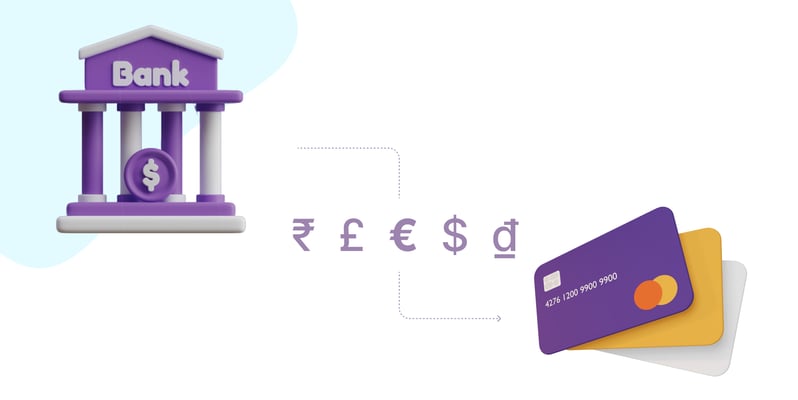Whether you're already using Stripe to accept payments or planning to do so, there's something you need to know. And what's that?
Stripe announced that it'd increase the international card fee from 1% to 1.5%. In addition, Stripe said it wouldn't refund its sellers the $15 dispute amount regardless of whether they win or lose the dispute.
In this blog, we'll discuss in detail what prices are changing and when. We'll also talk about how this change will impact your business and how you can tackle the same. So, read in full.
The Current Pricing Model: What's Stripe Charging its Merchants Now
You can integrate Stripe into your business and pay a flat fee of 2.9% + 30¢ for every successful card transaction. However, this fee is for cards issued within the United States. For a card issued outside the United States, i.e., for an international card, you'll have to pay 2.9% + 30¢ + 1% fee.
The Escalation of Pricing in Cross-Border Payments
Stripe has made the decision to make the following changes regarding its pricing:
International Card Fee
Initially, Stripe charged an additional international card transaction fee of 1% for every transaction. However, that fee has been hiked to 1.5% for every transaction. And the increased pricing will be effective from June 2023 for all merchants.
The standard pricing, although, for all US card transactions, will remain the same, i.e., 2.9% + $0.30 per transaction.
What does Stripe Recommend to its Sellers to Reduce Costs Amid the Price Increase?
Stripe recommends its customers (sellers) offer alternative payment methods to their customers as they're usually cheaper than cards. With Stripe, businesses can choose different payment methods and provide a localized checkout experience. And this can help reduce overall costs.
Dispute Fee
Whenever the customer files a chargeback request, a dispute is raised. And for this, the merchant was charged $15. If the merchant won the dispute, the money was refunded.
With Stripe's recent update, no dispute money will be refunded to the seller regardless of whether they win or lose the dispute. And this, again, will come into effect from June 2023.
What does Stripe Recommend to its Sellers to Reduce Chargebacks?
Stripe offers a service, Stripe Radar, that helps prevent fraudulent charges using machine learning. Merchants with their regular pricing can use this service for free and reduce chargebacks. And if there are fewer chargebacks, you won't have to pay a $15 dispute fee. In addition, Stripe helps you with the documentation you need to submit to help you fight the right chargebacks in the best way.
What's the Reason Behind This Price Hike and Policy Change?
-
International Card Fee
Stripe, as a payment gateway, is connected with numerous card networks such as VISA, MasterCard, AMEX, and more. And these card networks have been charging a higher fee from Stripe for international transactions for quite a long time. So, to reduce the costs it has been bearing for years, Stripe is hiking the additional transaction fee from June 2023.
-
Dispute Fee
Similar to international card transaction fees, card networks have hiked other existing fees and introduced new ones. To cover all these expenses, Stripe has decided not to return $15 to merchants whether they win or lose the dispute.
No matter how justified the price hike may sound, it can significantly impact businesses, both big and small. Let's understand how.
How Will These Changes Impact Your Business?
%20(1)-1.png?width=2500&height=2196&name=Infographic%20-%201%20(2)%20(1)-1.png)
1. Increase in the Pricing
One of the most direct impacts of the price hike is the increase in pricing, which the merchants will have to bear. If you're someone who accepts a high volume of international payments from customers via cards, your business could take a severe revenue hit impacting your bottom line.
2. Impact on Customer Experience
Let's say you initially bear the price hike made by Stripe. But eventually, you decide to pass on the increased price to your customers. While this can sound like the right thing to do financially, it can be devastating for your business, as it can impact your customer experience. They might start buying from your competitors, leading to a loss of sales and, thus, revenue.
3. Unnecessary Revenue Leaks
Chargebacks were crafted to protect consumers against fraud. While they do help consumers get their money back in case of fraud, most customers use this security feature for illicit means. And this can be a considerable revenue leak for merchants as regardless of the chargeback dispute decision; they'll have to pay the chargeback fee.
4. Impact on your Overall Business
If you're relying on a single payment gateway (say: Stripe) for now and cannot afford to bear any more expenses, the price hike can negatively impact your business. How? To save money, you'll try to find and integrate alternative payment gateways, which are time-consuming and costly. And during the transition period, you might lose sales and take a revenue hit which can impact your overall business.
How can inai Help you Stay Immune to Such Price Hikes or Policy Changes?
Here's how:
-1.png?width=2932&height=2672&name=Infographic%20-%202%20(2)-1.png)
1. Reduce Dependency on a Single Payment Gateway
inai is a payment aggregation platform that can connect you with more than 30 payment gateways. This way, you have multiple options to choose from.
If one payment gateway hikes its price or experiences downtime, you can always switch to a more reliable and affordable option to ensure a seamless payment flow. In short, inai can help you reduce your dependency on a single payment gateway and become more flexible.
Good read: Why Do You Need Multiple Payment Gateways?
2. Reduce Payment/Transaction Fee
Suppose your existing payment gateway 'X' costs 1.5% per transaction. And a payment gateway 'Y' with similar features charges 1.0% per transaction.
Without inai, you have no option but to continue with your existing payment gateway and bear a high transaction fee. Even if you try to switch to some other payment gateway or add more payment gateways manually, it'll be a logistically and financially tough decision.
However, with inai, you can route every transaction via the most affordable payment gateway with just a flick of a button. This way, you can reduce the overall payment or transaction fee and thus save money.
3. Reduce Overall Costs
Credit and debit cards, especially international ones, are known to cost much more than alternative payment methods. Promoting APMs (digital wallets, UPI) that customers prefer can help you reduce overall costs.
But you can offer only so many alternative payment methods to your customers using a single payment gateway.
However, with inai, you can integrate over 30 payment gateways and offer 300+ local and global payment methods. This way, you can offer more payment methods to your customers and reduce reliance on credit or debit cards, thus reducing overall costs.
4. Optimize Checkout Experience
In addition to helping you offer more payment methods and reducing transaction & overall costs, inai also enables you to optimize your checkout experience. You can customize the checkout based on your customer preferences and offer them a localized experience. This will help reduce customer churn and boost conversions.
Good read: 10 Ways to Improve Your Checkout Conversion Rates in Southeast Asia
Wrapping Up
Hiking prices are not something new in the finance or payments industry. Companies do that all the time to improve their revenue, reduce costs, and for several other reasons. However, businesses can deal with such changes effectively by utilizing payment orchestration solutions like inai.
The most significant advantage of integrating a payment orchestrator is the reduced reliance on a single payment gateway. When merchants have numerous options, sudden pricing or policy changes don't impact or disrupt the regular flow of payments.
.png?width=123&height=71&name=inai%20logo%20-%20dark%201(1).png)
.png)
-1.png?width=4068&height=1080&name=CTA%20(10)-1.png)

.png?height=400&name=Header%20-%20How%20Can%20Merchants%20Reduce%20the%20Risk%20of%20Chargebacks_%20(1).png)
.png?width=50&name=karthik%20(1).png)



.jpg?width=50&name=IMG_5672%20(1).jpg)